In late 1945, as the Pacific war wound down, the USN found itself with three large surface warships still under construction, Illinois and Kentucky of the Iowa class, and Hawaii of the Alaska class. Illinois had been laid down in December 1942, at Philadelphia Naval Shipyard, and by August 1945, she was only 22% complete. The decision was made to cancel her, and although there were proposals that her hull be saved for use as a nuclear target, the $30 million it would have cost to bring her to such a state meant that it never happened, and she was broken up in 1958.
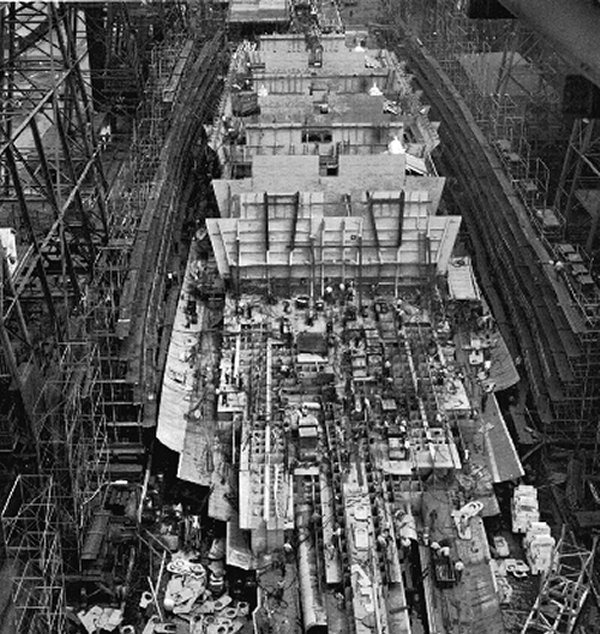
Illinois in July 1945
Kentucky was in somewhat better shape, and survived the axe for far longer. She had originally been laid down at Norfolk Navy Yard in March of 1942, but three months later, the assembled structure was launched to clear the slipway for LST construction. It remained tied up until December 1944, when it was moved into a drydock at the yard, and work resumed. A great deal of material had been gathered in the intervening months, and assembly progressed very quickly. Unlike her sister, Kentucky survived the end of the war, and work continued until August of 1946, when she was suspended while the Navy figured out what they wanted to do with her. The story was much the same for the large cruiser Hawaii. She had been laid down in December 1943, and launched two months after the end of the war. Although she was 82% complete, including installation of her turrets, the Navy decided that they might want to do something besides complete her to the original design. The prospect of having a couple of big, fast hulls to play with drew naval architects, both professional and amateur, in huge numbers, and produced some fascinating designs, although ultimately, both ships would be scrapped.
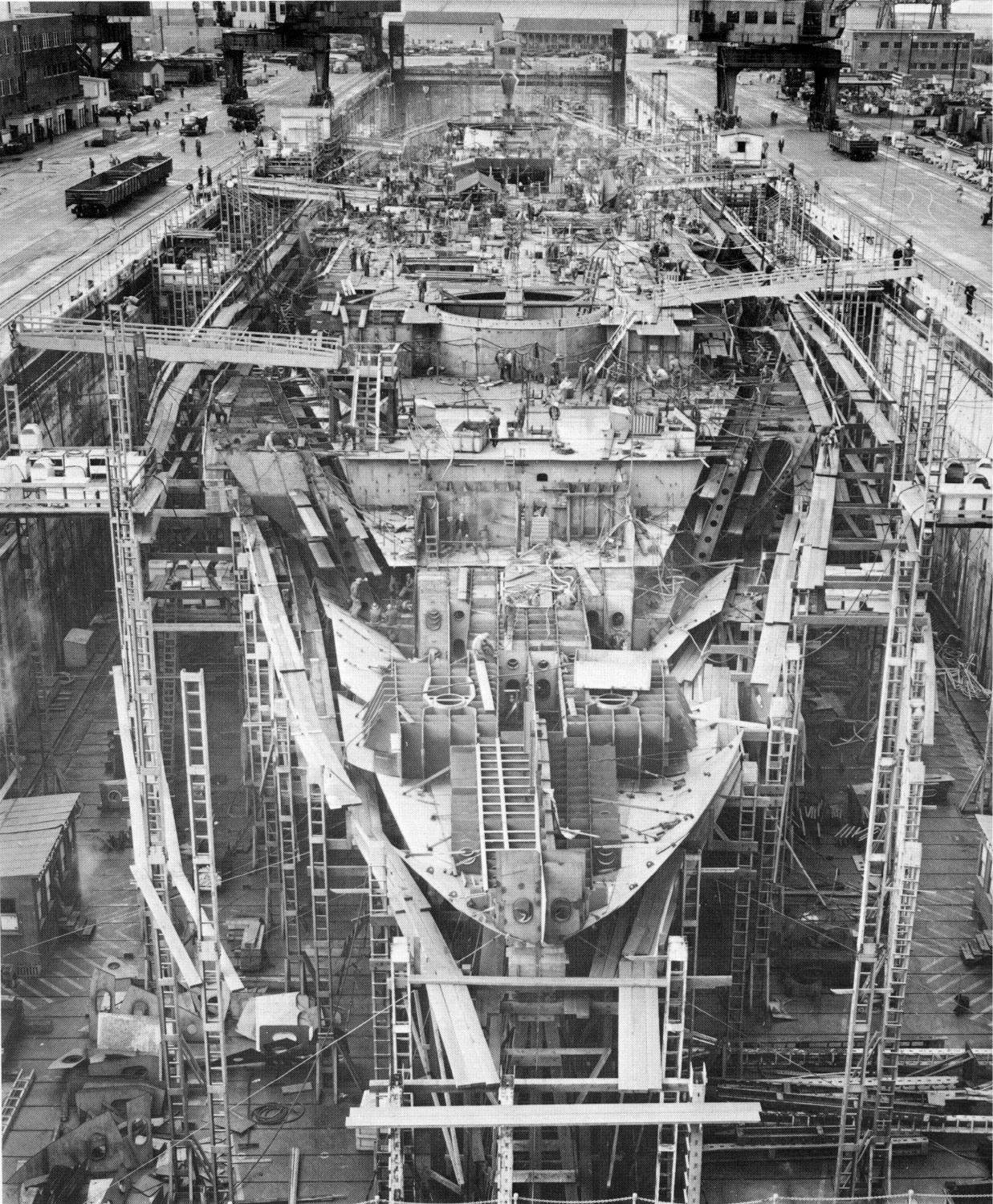
Kentucky under construction
In 1946, the plan for Kentucky was to complete her as an anti-aircraft battleship, continuing what had been a major role of the fast battleships during the war. Surface-to-air missiles were still in early development, and the plan was to use 8" guns firing subcaliber 4" guided projectiles. While such plans are common today, it would have probably been infeasible given the technology of the day, and the program was axed in the budget crunch of the late 40s. That same year, Hawaii was slated for completion as a missile test ship, carrying some combination of Loon, a proto-Talos, and V-2s in stabilized pits. This conversion was cancelled thanks to the immaturity of the missiles, which would be tested instead on the former battleship Mississippi.
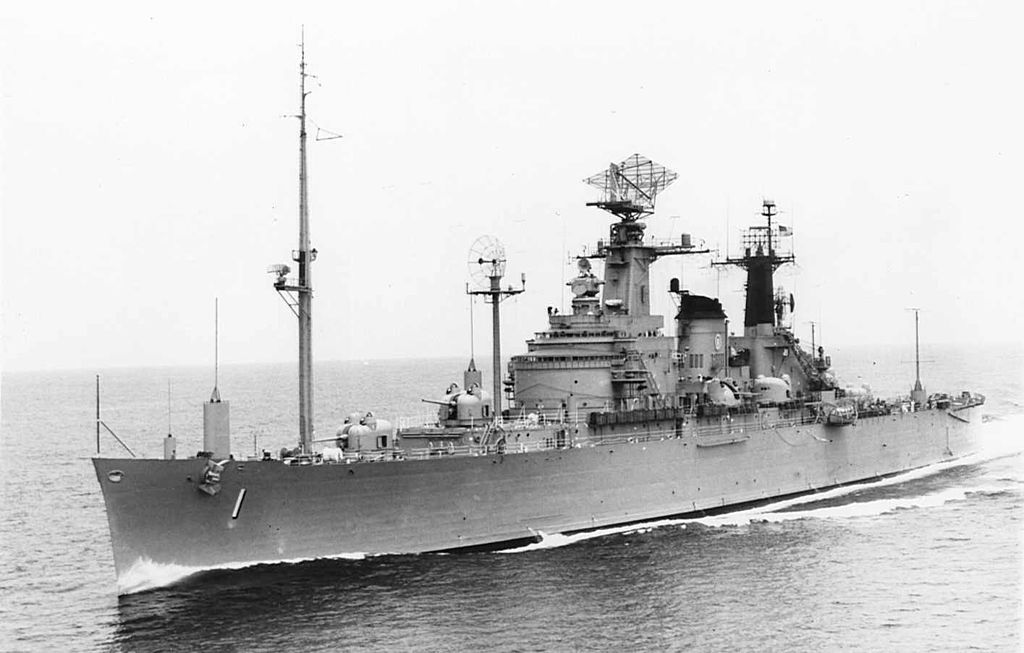
Northampton as a command ship
Some plans were made to use Hawaii as a missile ship after the designs had stabilized, but they were scrapped when she was slated for completion as a command ship, instead. In the late 40s, it was expected that the carriers required for the nuclear strike role would be flush-decked, which left little room for radars and radio antennas. Another ship would need to carry those, also serving as the flagship of the carrier group. The incomplete cruiser Northampton was finished as the first of the type, while Hawaii's 12" turrets were removed in preparation for her conversion. The program died due to the development of the angled deck, which allowed the carrier to have its own antennas, and inadequate shipbuilding budgets.
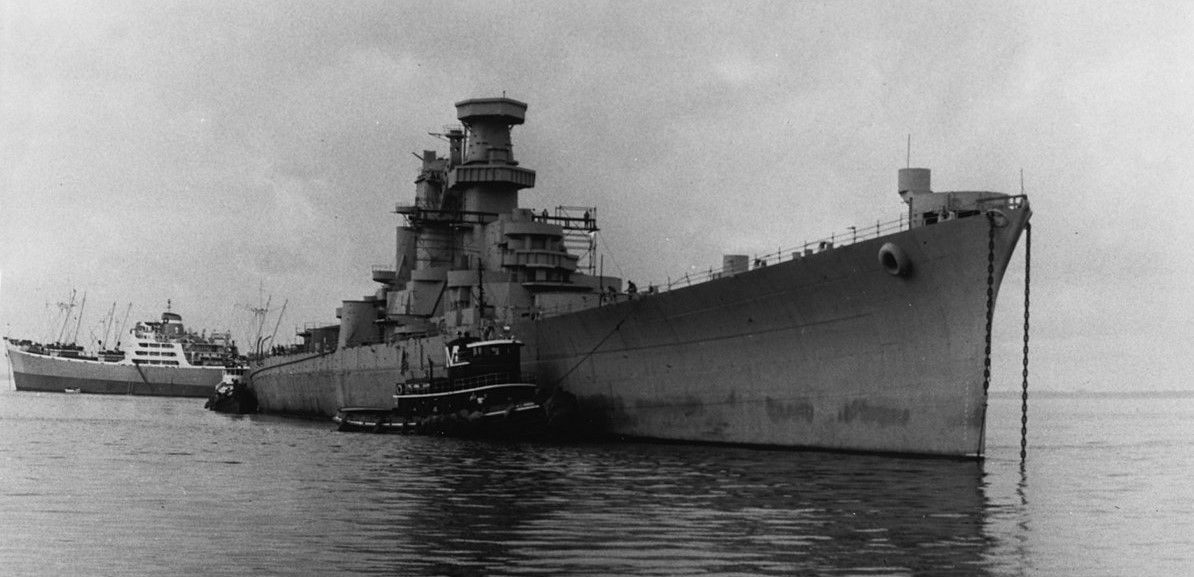
This put the missile cruiser conversion of Hawaii back on the table, in parallel with similar plans for Kentucky. The plan for the latter, designated a BBG for guided-missile battleship, was to delete Turret II and install 5"/54s and 3"/50s for air defense, as well as a twin Talos and twin Tartar launcher. Long-range striking power would come from 8 Regulus II missiles, the longest-range weapons available to the striking force it was expected to be a part of. Five BBGs were desired, to be met by converting the four finished Iowas as well as Kentucky. As the design developed, gunpower was deemphasized, and more missiles were crammed in. A later draft saw the Regulus II replaced by two launchers for Polaris, with a total of 16 missiles onboard, 4 Talos launchers with 80 missiles each and 12 Tartar launchers with 42 missiles each. While the hull was indeed big enough to accommodate these, electronic interference between the guidance radars meant that the practical battery was more like 2 Talos and 4 Tartar, which was only slightly more firepower than carried by the contemporary Albany class cruisers. That essentially killed off the idea, although proposals for BBG conversions continued to be floated until the end of the decade. Similar considerations doomed similar plans for Hawaii and her sisters. A 2 Talos 4 Terrier ship with 20 Polaris in tubes aft (a forerunner of the modern VLS) would have cost about $125 million, as opposed to $90 million for a heavy cruiser conversion.
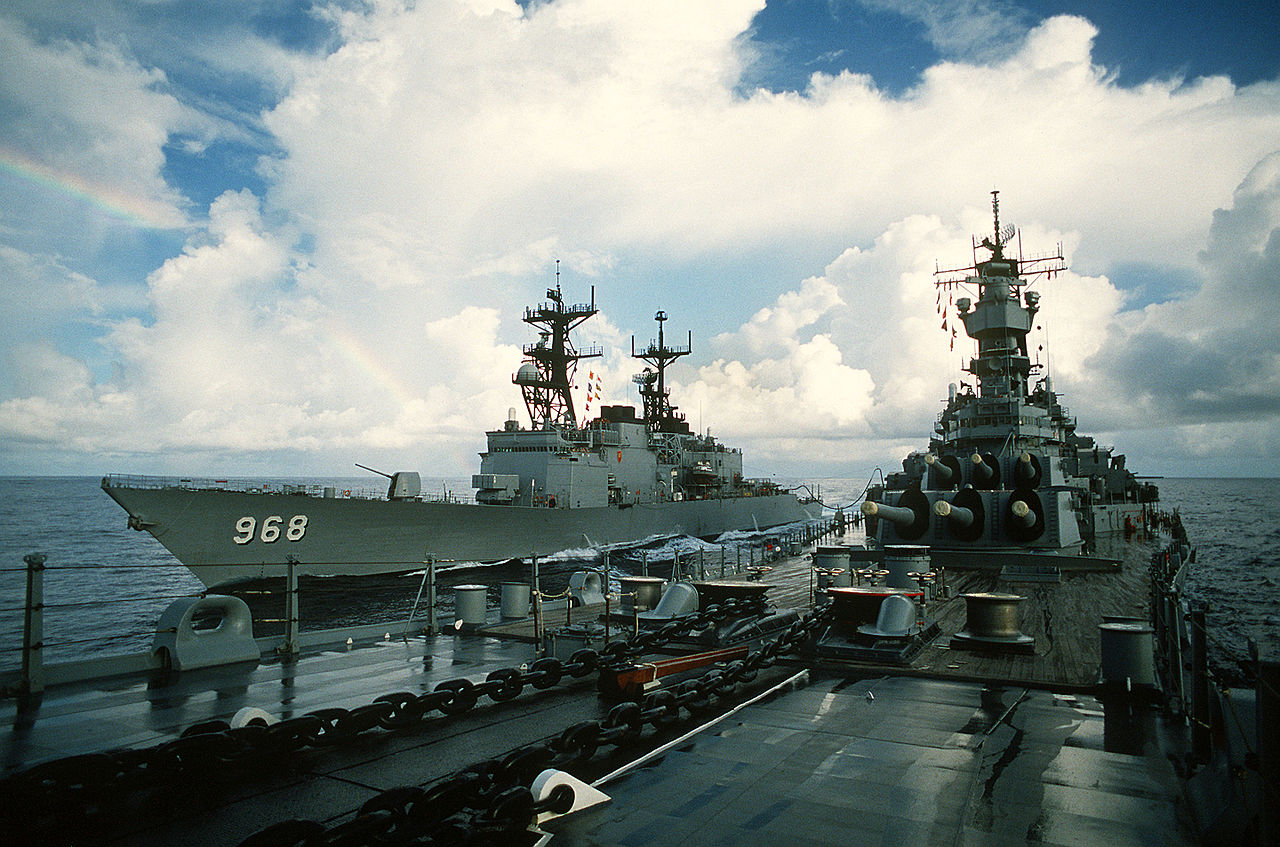
Iowa refueling destroyer Arthur W Radford in the 1980s
Many of the conversions also included a secondary role. During WWII, underway replenishment had enabled the USN to operate further forward than had previously been possible. However, existing tankers were slow, and would be vulnerable to attack. The Iowas had already done sterling work refueling destroyers during the war, and were thought to be ideal candidates. Iowa and Wisconsin had already been modified with kingposts for improved refuling performance during the last years of their second commissions. As pure oilers, they would indeed be able to offload 6,500 tons of fuel with minimal modifications, and could make 26 kts with only half of their engines active. But the result would be expensive to operate and less effective than a purpose-built oiler. Proposals for this work, which would probably take place on one of the completed Iowas, lasted through the early 60s, sometimes combined with flagship functions.
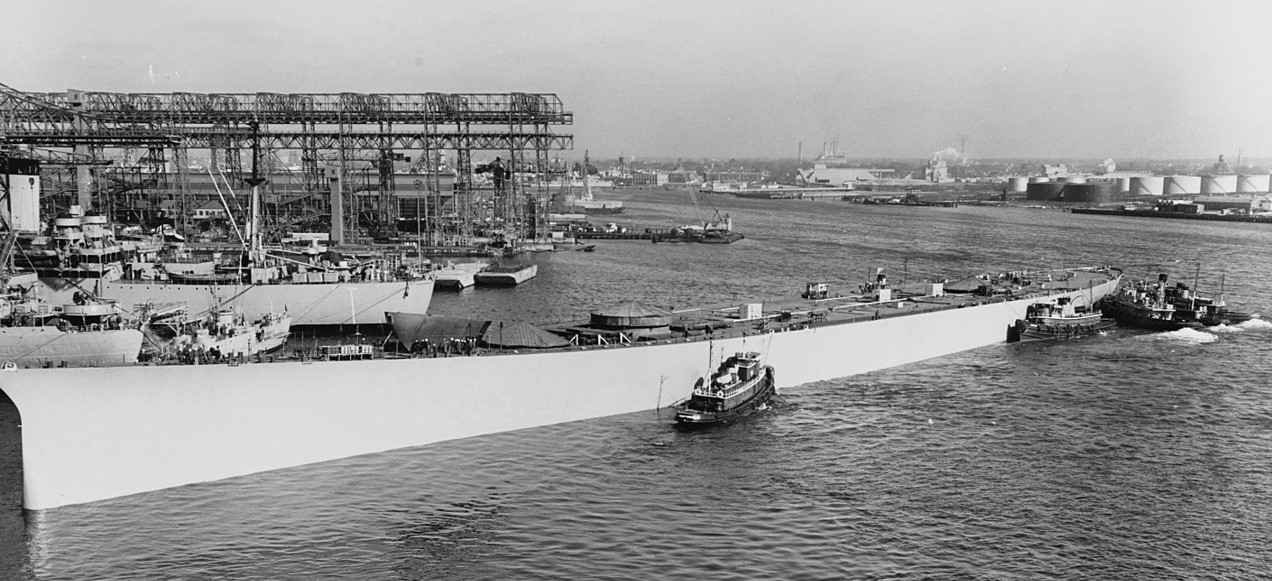
Kentucky being floated out of the drydock
But ultimately, none of these plans came to fruition.1 Kentucky’s hull was floated out of the drydock in 1950. It's traditionally said that this was to make way for Missouri after her visit to Thimble Shoal, but there is evidence that the float-out was planned months before Missouri’s grounding. Work never resumed, and a section from her bow was removed and used to repair Wisconsin after a collision with the destroyer Eaton in 1956. She was stricken, along with Hawaii, on June 9th, 1958, and both hulls went to the scrapyard. Kentucky's boilers were saved, and ended up helping to solve the replenishment ship problem. They were used in the fast support ships Sacramento and Camden, and the engineering crews of those ships proved important to the reactivated Iowas. But even without partially-built ships available, plans for alternate uses of the existing battleships continued to be mooted through the 1980s. We'll pick up the story there next time.
1 It's also worth noting a plan made for the use of the older North Carolina and South Dakota classes. BuShips was asked to investigate raising their speed to 31 kts, which would have taken 240,000 SHP for North Carolina and 256,000 SHP for South Dakota, vice 212,000 SHP on Iowa. Even removing Turret III wouldn't have given enough room. To reduce this, they looked at lowering displacement by removing the main armored belt, which would have brought the power requirements into the territory of "remotely reasonable". However, the cost was still too high, and the plan was scrapped. ⇑

Comments
...I'm not sure anything could have been done with the SoDaks - they were without question good ships, but it seems that they had stuffed just about all they could have into those hulls.
You're right on that, and the North Carolina upgrades were pursued slightly further than the SoDak version. Both were essentially paper projects, though, and died pretty quickly.
I've always been curious how aware the navy was of the war's progression. Were their building programs caught flat-footed? Were they playing it safe in case of a reverse-Midway? Were they just trying to get as many ships ordered as possible for post war budget negotiations?
It definitely didn't take them by surprise, and there was active debate during the war over how many ships they should lay down that might or might not be completed until later. King in particular seems to have wanted to build the biggest fleet he could while the checkbook was out, and he and others went a long way to accomplishing that goal. It seems to have turned out pretty well, despite the upending of warfare by the atomic bomb, with only a few serious missteps (the ships described here most prominent among them).